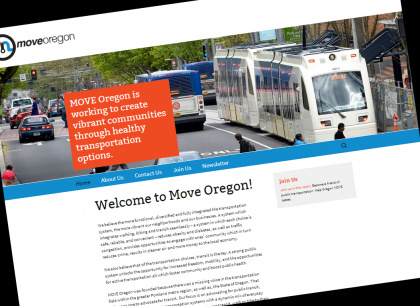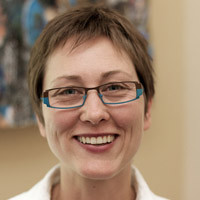
A team of heavy hitters from Portland’s private, public and nonprofit sectors has teamed up to create what looks like Oregon’s most important new transportation nonprofit in years.
It’s setting out to be, in a sense, public transportation’s answer to the Bicycle Transportation Alliance or to AAA Oregon.
In the five months since BikePortland reported on the group’s formation, Move Oregon — that’s its new name — has recruited a bike-friendly director and an impressive board that includes BTA Executive Director Rob Sadowsky, BTA-director-turned-planning-consultant Catherine Ciarlo, Portland Streetcar Executive Director Rick Gustafson and Portland Business Alliance Vice President Bernie Bottomly.
“The Portland metro region is supposed to realize quite a large population influx,” said Move Oregon Director Katja Dillmann, a former transportation policy director for Mayor Sam Adams who also serves on the board of Oregon Walks. “Everyone in the business community that I’m interacting with understands that there is no way we’re going to build enough roads to accommodate that. Nor would we want to.”
That’s why the group’s focus, it says on its new website, will be to provide a “missing voice” for better public transportation in the Portland area and around the state. It’s describing that work as part of “a system which integrates walking, biking and transit seamlessly – a system in which each choice is safe, reliable, and convenient.”
To that end, Dillmann said, the group’s organizers have agreed never to support a political horse-trade that would increase transit funding at the expense of an ally.
“Should we ever been in that hard place where it’s transit versus biking or transit versus walking, we would never sell ourselves down the river,” she said.
“Movements don’t do well when we’re picking each other apart,” Sadowsky said in a phone interview Tuesday. “Movements don’t do well when we say, ‘Fund this but don’t fund that.'”
Sadowsky said he thinks Move Oregon can be a voice that can join with the BTA to make the case for new revenue at both the state and local levels that could pay to improve transit and bike infrastructure.
“It has to be a coalition” leading the charge for such proposals, Sadowsky said. “If it’s not a partnership, it’s not going to pass.”
Move Oregon’s first two priorities, Dillmann said, will be to oppose an anti-transit ballot issue in Tigard this spring and to push for some sort of new revenue stream during Oregon’s 2015 legislative session that could be used for public transit operations.
As we wrote in July, Move Oregon is the brainchild of David Knowles, a longtime public- and private-sector executive in Portland inspired by the Seattle-based Transportation Choices Coalition.

leaders of the BTA, both sit on the board of
a new group that in some ways wants
to be the BTA of public transportation.
(Photo by J.Maus/BikePortland)
What makes this nonprofit advocacy group unusual (for the Portland area, at least) is that it’s being founded with close ties to local business advocates. The group’s official address, at least for the moment, is the office of the Portland Business Alliance, our regional chamber of commerce — and a group that regularly (though not always) disagrees with transportation advocates about whether street space is best dedicated to walking, driving, biking or parking.
That’s why it’s heartening to see the organization talking about an integrated low-car transportation system — and presumably writing some checks to support it.
It’ll be interesting to see how Move Oregon carves out a different identity from OPAL Environmental Justice Oregon, the environmental justice nonprofit that advocates for “transit-dependent” Portlanders, often by challenging TriMet over internal priorities such as light rail construction. (OPAL, meanwhile, seems to be close to a significant victory: an extension of transfer times from two hours to 2.5 hours.)
Sadowsky said he, Chris Rall and former Oregon Walks Director Steph Routh had urged the new organization to more closely involve OPAL as a collaborator, with some success. It’s an example, he said, of how the group is continuing to shape its own identity and direction.
“I don’t think Move Oregon sees itself as saying, ‘We’re the group that thinks light rail has to be the best way,'” Sadowsky said. “Move Oregon can’t be about what TriMet feels or OPAL feels. Move Oregon has to be seen as its own independent organization. That’s what takes time.”
Other big questions for this group will be its positions on two issues that divide local transit advocates: whether TriMet should be deeply cutting the health benefits of its union retirees, and whether it’s worth endorsing major road projects such as the Columbia River Crossing if they also include substantial transit and biking improvements.
Dillmann said Move Oregon hasn’t yet been able to shape its position on either of those issues, though she said “there is an awareness that there will be highway money involved” in any state transportation package in 2015.
We’re encouraged by the language this group is using so far, and eager to see how its words will translate into action.


